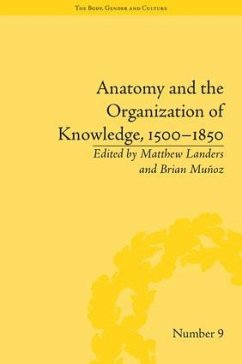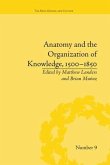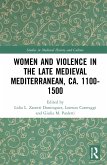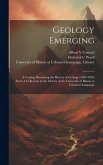Brian Muñoz
Anatomy and the Organization of Knowledge, 1500-1850
Brian Muñoz
Anatomy and the Organization of Knowledge, 1500-1850
- Gebundenes Buch
- Merkliste
- Auf die Merkliste
- Bewerten Bewerten
- Teilen
- Produkt teilen
- Produkterinnerung
- Produkterinnerung
Across early modern Europe, the growing scientific practice of dissection prompted new and insightful ideas about the human body. This collection of essays explores the impact of anatomical knowledge on wider issues of learning and culture.
Andere Kunden interessierten sich auch für
![Anatomy and the Organization of Knowledge, 1500-1850 Anatomy and the Organization of Knowledge, 1500-1850]() Anatomy and the Organization of Knowledge, 1500-185053,99 €
Anatomy and the Organization of Knowledge, 1500-185053,99 €![The Artisan and the European Town, 1500-1900 The Artisan and the European Town, 1500-1900]() The Artisan and the European Town, 1500-1900227,99 €
The Artisan and the European Town, 1500-1900227,99 €![Small Wars and Insurgencies in Theory and Practice, 1500-1850 Small Wars and Insurgencies in Theory and Practice, 1500-1850]() Small Wars and Insurgencies in Theory and Practice, 1500-1850238,99 €
Small Wars and Insurgencies in Theory and Practice, 1500-1850238,99 €![Women and Violence in the Late Medieval Mediterranean, ca. 1100-1500 Women and Violence in the Late Medieval Mediterranean, ca. 1100-1500]() Women and Violence in the Late Medieval Mediterranean, ca. 1100-1500204,99 €
Women and Violence in the Late Medieval Mediterranean, ca. 1100-1500204,99 €![Geology Emerging: A Catalog Illustrating the History of Geology (1500-1850) From A Collection in the Library of the University of Illino Geology Emerging: A Catalog Illustrating the History of Geology (1500-1850) From A Collection in the Library of the University of Illino]() Dederick C. WardGeology Emerging: A Catalog Illustrating the History of Geology (1500-1850) From A Collection in the Library of the University of Illino46,99 €
Dederick C. WardGeology Emerging: A Catalog Illustrating the History of Geology (1500-1850) From A Collection in the Library of the University of Illino46,99 €![Exile and Religious Identity, 1500-1800 Exile and Religious Identity, 1500-1800]() Gary K WaiteExile and Religious Identity, 1500-1800227,99 €
Gary K WaiteExile and Religious Identity, 1500-1800227,99 €![Sex, Identity and Hermaphrodites in Iberia, 1500-1800 Sex, Identity and Hermaphrodites in Iberia, 1500-1800]() Francisco Vazquez GarciaSex, Identity and Hermaphrodites in Iberia, 1500-1800227,99 €
Francisco Vazquez GarciaSex, Identity and Hermaphrodites in Iberia, 1500-1800227,99 €-
-
-
Across early modern Europe, the growing scientific practice of dissection prompted new and insightful ideas about the human body. This collection of essays explores the impact of anatomical knowledge on wider issues of learning and culture.
Hinweis: Dieser Artikel kann nur an eine deutsche Lieferadresse ausgeliefert werden.
Hinweis: Dieser Artikel kann nur an eine deutsche Lieferadresse ausgeliefert werden.
Produktdetails
- Produktdetails
- Verlag: Routledge
- Seitenzahl: 272
- Erscheinungstermin: 1. Juli 2012
- Englisch
- Abmessung: 240mm x 161mm x 19mm
- Gewicht: 575g
- ISBN-13: 9781848933217
- ISBN-10: 1848933215
- Artikelnr.: 43750446
- Herstellerkennzeichnung
- Libri GmbH
- Europaallee 1
- 36244 Bad Hersfeld
- gpsr@libri.de
- Verlag: Routledge
- Seitenzahl: 272
- Erscheinungstermin: 1. Juli 2012
- Englisch
- Abmessung: 240mm x 161mm x 19mm
- Gewicht: 575g
- ISBN-13: 9781848933217
- ISBN-10: 1848933215
- Artikelnr.: 43750446
- Herstellerkennzeichnung
- Libri GmbH
- Europaallee 1
- 36244 Bad Hersfeld
- gpsr@libri.de
Matthew Landers is an Assistant Professor of Humanities at the University of Puerto Rico, Mayagüez, where he teaches courses in eighteenth-century British literature and the Enlightenment. He is currently working on a manuscript that examines the relationship between anatomy, philosophy and literature in Europe during the seventeenth and eighteenth centuries. In addition, he has just started work on a new project that reconstructs the development of the word 'culture' in the eighteenth century. He regularly collaborates in the creation of interdisciplinary courses that combine the concerns of the humanities with those of the biological and physical sciences., Brian Muñoz (co-editor) is a doctor of philosophy from the University of Malaga, Spain (2002) and from the University of Paris X Nanterre, France (2007). He worked as an assistant professor at the University of Lyon I Claude Bernard until 2004. He was a professor at the University of Puerto Rico from 2007 to 2012. Currently he is a collaborative researcher with S2HEP (Science et société, Historicité, Education et Pratiques, University of Lyon and Ecole Normale Supérieur de Lyon). His research areas are contemporary and modern philosophy. His work with S2HEP deals with body and health transformations, especially in neuroethics. He has published several peer-reviewed essays and has arranged numerous conferences in an international context.
Introduction, Matthew Landers; Part 1 The Body as a Map; Chapter 1 Early
Modern Dissection as a Model of Organization, Matthew Landers; Chapter 2
'Who Will Not Force a Mad Man to be Let Blood?': Circulation and Trade in
the Early Eighteenth Century, Amy Witherbee; Chapter 3 Earth's Intelligent
Body: Subterranean Systems and the Circulation of Knowledge, or, the Radius
Subtending Circumnavigation, Kevin L. Cope; Chapter 4 'After an Unwonted
Manner': Anatomy and Poetical Organization in Early Modern England, Mauro
Spicci; Chapter 5 Subtle Bodies: The Limits of Categories in Girolamo
Cardano's De Subtilitate, Sarah Parker; Part 2 The Collective Body; Chapter
6 Mirroring, Anatomy, Transparency: The Collective Body and the Co-Opted
Individual in Spenser, Hobbes and Bunyan, Nick Davis; Chapter 7 From Human
to Political Body and Soul: Materialism and Mortalism in the Political
Theory of Thomas Hobbes, Ionut Untea; Chapter 8 Visualizing the Fibre-Woven
Body: Nehemiah Grew's Plant Anatomy and the Emergence of the Fibre Body,
Hisao Ishizuka; Chapter 9 Forms of Materialist Embodiment, Charles T.
Wolfe; Part 3 Bodies Visualized; Chapter 10 Visualizing Monsters: Anatomy
as a Regulatory System, Touba Ghadessi; Chapter 11 Anatomy, Newtonian
Physiology and Learned Culture: The Myotomia Reformata and its Context
within Georgian Scholarship, Craig Ashley Hanson; Chapter 12 Art and
Medicine: Creative Complicity Between Artistic Representation and Research,
Filippo Pierpaolo Marino; Chapter 13 The Internal Environment: Claude
Bernard's Concept and its Representation in Fantastic Voyage, Jérôme
Goffette, Jonathan Simon;
Modern Dissection as a Model of Organization, Matthew Landers; Chapter 2
'Who Will Not Force a Mad Man to be Let Blood?': Circulation and Trade in
the Early Eighteenth Century, Amy Witherbee; Chapter 3 Earth's Intelligent
Body: Subterranean Systems and the Circulation of Knowledge, or, the Radius
Subtending Circumnavigation, Kevin L. Cope; Chapter 4 'After an Unwonted
Manner': Anatomy and Poetical Organization in Early Modern England, Mauro
Spicci; Chapter 5 Subtle Bodies: The Limits of Categories in Girolamo
Cardano's De Subtilitate, Sarah Parker; Part 2 The Collective Body; Chapter
6 Mirroring, Anatomy, Transparency: The Collective Body and the Co-Opted
Individual in Spenser, Hobbes and Bunyan, Nick Davis; Chapter 7 From Human
to Political Body and Soul: Materialism and Mortalism in the Political
Theory of Thomas Hobbes, Ionut Untea; Chapter 8 Visualizing the Fibre-Woven
Body: Nehemiah Grew's Plant Anatomy and the Emergence of the Fibre Body,
Hisao Ishizuka; Chapter 9 Forms of Materialist Embodiment, Charles T.
Wolfe; Part 3 Bodies Visualized; Chapter 10 Visualizing Monsters: Anatomy
as a Regulatory System, Touba Ghadessi; Chapter 11 Anatomy, Newtonian
Physiology and Learned Culture: The Myotomia Reformata and its Context
within Georgian Scholarship, Craig Ashley Hanson; Chapter 12 Art and
Medicine: Creative Complicity Between Artistic Representation and Research,
Filippo Pierpaolo Marino; Chapter 13 The Internal Environment: Claude
Bernard's Concept and its Representation in Fantastic Voyage, Jérôme
Goffette, Jonathan Simon;
Introduction, Matthew Landers; Part 1 The Body as a Map; Chapter 1 Early
Modern Dissection as a Model of Organization, Matthew Landers; Chapter 2
'Who Will Not Force a Mad Man to be Let Blood?': Circulation and Trade in
the Early Eighteenth Century, Amy Witherbee; Chapter 3 Earth's Intelligent
Body: Subterranean Systems and the Circulation of Knowledge, or, the Radius
Subtending Circumnavigation, Kevin L. Cope; Chapter 4 'After an Unwonted
Manner': Anatomy and Poetical Organization in Early Modern England, Mauro
Spicci; Chapter 5 Subtle Bodies: The Limits of Categories in Girolamo
Cardano's De Subtilitate, Sarah Parker; Part 2 The Collective Body; Chapter
6 Mirroring, Anatomy, Transparency: The Collective Body and the Co-Opted
Individual in Spenser, Hobbes and Bunyan, Nick Davis; Chapter 7 From Human
to Political Body and Soul: Materialism and Mortalism in the Political
Theory of Thomas Hobbes, Ionut Untea; Chapter 8 Visualizing the Fibre-Woven
Body: Nehemiah Grew's Plant Anatomy and the Emergence of the Fibre Body,
Hisao Ishizuka; Chapter 9 Forms of Materialist Embodiment, Charles T.
Wolfe; Part 3 Bodies Visualized; Chapter 10 Visualizing Monsters: Anatomy
as a Regulatory System, Touba Ghadessi; Chapter 11 Anatomy, Newtonian
Physiology and Learned Culture: The Myotomia Reformata and its Context
within Georgian Scholarship, Craig Ashley Hanson; Chapter 12 Art and
Medicine: Creative Complicity Between Artistic Representation and Research,
Filippo Pierpaolo Marino; Chapter 13 The Internal Environment: Claude
Bernard's Concept and its Representation in Fantastic Voyage, Jérôme
Goffette, Jonathan Simon;
Modern Dissection as a Model of Organization, Matthew Landers; Chapter 2
'Who Will Not Force a Mad Man to be Let Blood?': Circulation and Trade in
the Early Eighteenth Century, Amy Witherbee; Chapter 3 Earth's Intelligent
Body: Subterranean Systems and the Circulation of Knowledge, or, the Radius
Subtending Circumnavigation, Kevin L. Cope; Chapter 4 'After an Unwonted
Manner': Anatomy and Poetical Organization in Early Modern England, Mauro
Spicci; Chapter 5 Subtle Bodies: The Limits of Categories in Girolamo
Cardano's De Subtilitate, Sarah Parker; Part 2 The Collective Body; Chapter
6 Mirroring, Anatomy, Transparency: The Collective Body and the Co-Opted
Individual in Spenser, Hobbes and Bunyan, Nick Davis; Chapter 7 From Human
to Political Body and Soul: Materialism and Mortalism in the Political
Theory of Thomas Hobbes, Ionut Untea; Chapter 8 Visualizing the Fibre-Woven
Body: Nehemiah Grew's Plant Anatomy and the Emergence of the Fibre Body,
Hisao Ishizuka; Chapter 9 Forms of Materialist Embodiment, Charles T.
Wolfe; Part 3 Bodies Visualized; Chapter 10 Visualizing Monsters: Anatomy
as a Regulatory System, Touba Ghadessi; Chapter 11 Anatomy, Newtonian
Physiology and Learned Culture: The Myotomia Reformata and its Context
within Georgian Scholarship, Craig Ashley Hanson; Chapter 12 Art and
Medicine: Creative Complicity Between Artistic Representation and Research,
Filippo Pierpaolo Marino; Chapter 13 The Internal Environment: Claude
Bernard's Concept and its Representation in Fantastic Voyage, Jérôme
Goffette, Jonathan Simon;








